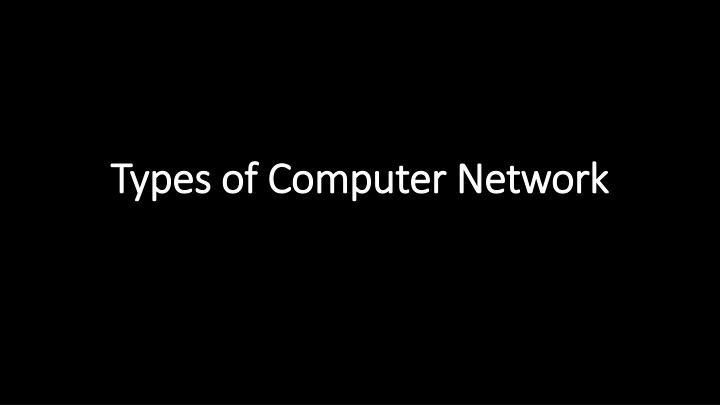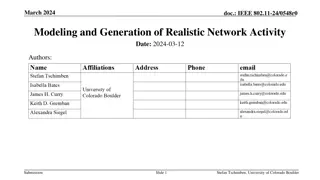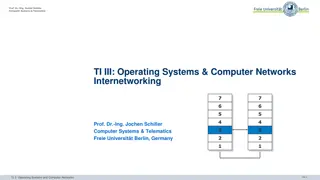
Types of Computer Networks: LAN, MAN, WAN, CAN, PAN
Explore the classification of computer networks based on geography and components, including LAN, MAN, WAN, CAN, and PAN. Learn about their characteristics and applications in different settings.
Download Presentation

Please find below an Image/Link to download the presentation.
The content on the website is provided AS IS for your information and personal use only. It may not be sold, licensed, or shared on other websites without obtaining consent from the author. If you encounter any issues during the download, it is possible that the publisher has removed the file from their server.
You are allowed to download the files provided on this website for personal or commercial use, subject to the condition that they are used lawfully. All files are the property of their respective owners.
The content on the website is provided AS IS for your information and personal use only. It may not be sold, licensed, or shared on other websites without obtaining consent from the author.
E N D
Presentation Transcript
Types of Computer Network Types of Computer Network
Types of Computer Network Types of Computer Network Networks are classified depending on the geography & their components role and Trasmission Technology 1. Classification of network by their geography: LAN - Local Area Network MAN - Metropolitan Area Network WAN - Wide Area Network CAN - Campus Area Network PAN - Personal Area Network 2. Classification by their components by their component role: 1. Peer-to- Peer Network 2. Client-server network
Personal Area Network (PAN) A Personal Area Network (PAN) is smallest network which is very personal to a user. This may include Bluetooth enabled devices or infra-red enabled devices. PAN has connectivity range up to 10 meters. PAN may include wireless computer keyboard and mouse, Bluetooth enabled headphones, wireless printers, and TV remotes. The communication network established for the purpose of connecting computer devices of personal use is known as the PAN
Campus Area Network (CAN) CAN is a Campus Area Network is used to connect buildings across campuses of colleges or Universities. A CAN is actually a type of LAN. It is larger than a LAN but smaller than MAN. CAN is a network that connects two or more LANs but that is limited to a specific and contiguous geographical area such as a college campus, industrial complex or military base
Campus Area Network (CAN) Advantages: 1. CAN is economical. 2. CAN is simple and easy to implement. 3. Helpful for universities & corporate organization to work from any block and receive the same speed of data together
Local Area Network (LAN) A computer network spanned inside a building and operated under single administrative system (private) is generally termed as Local Area Network (LAN). Usually, LAN covers an organization offices, schools, colleges or universities. Number of systems connected in LAN may vary from as least as two to as much as 16 million. LAN provides a useful way of sharing the resources between end users. The resources such as printers, file servers, scanners, and internet are easily sharable among computers.
Local Area Network (LAN) Advantages: The reliability of network is high because the failure of the computer in the network does not affect the functioning for other computers. Addition of new computer to network is easy. High rate of data transmission is possible. Loss expensive to install.
Metropolitan Area Network (MAN) A Metropolitan Area Network (MAN) is a large computer network that spans a metropolitan area. A MAN typically covers an area up to 10 kms (city). The best example of MAN is the cable Television network, available in many cities. For an organization, the common use of a MAN is to extend their LAN connectivity between buildings/offices that are within the same city or urban area (hence the name Metropolitan Area Network). From the customer's point of view, the MAN looks like one big (long) Ethernet link between their offices. The different sites could belong to the same IP subnet, and from the customer's viewpoint, no routing is required between their sites.
Wide Area Network (WAN) A Wide Area Network is a network that extends over a large geographical area such as states or countries. A Wide Area Network is quite bigger network than the LAN. A Wide Area Network is not limited to a single location, but it spans over a large geographical area through a telephone line, fibre optic cable or satellite links. The internet is one of the biggest WAN in the world. A Wide Area Network is widely used in the field of Business, government, and education.
LAN vs MAN vs WAN LAN vs MAN vs WAN Parameter LAN MAN WAN LAN is an acronym for Local Area Network. MAN is an acronym for Metropolitan Area Network. WAN is an acronym for Wide Area Network. The WAN network spans to an even larger locality. It has the capacity to connect various countries together. For example, the Internet is a WAN. Full Form LAN is a network that usually connects a small group of computers in a given geographical area. MAN is a comparatively wider network that covers large regions- like towns, cities, etc. Definition and Meaning The MAN can be both private or public. Many organizations and telecom operators may own Comparatively difficult and maintain. MAN offers a moderate Internet speed. It faces a moderate propagation delay. It basically covers a city, a small town, or any given area with a bigger radius than the LAN. The LAN is private. Hospitals, homes, schools, offices, etc., may own it. Network Ownership The WAN can also be both private or public. Maintenance and Designing to design Very difficult to design and maintain. WAN offers a low Internet speed. It faces a high propagation delay. It covers an entire country, a subcontinent, or an equivalent area. Very easy to design and maintain. LAN offers a very high Internet speed. It faces a very short propagation delay. Schools, homes, colleges, hospitals, offices, etc., can privately use it. Speed Delay in Propagation Uses
Types of Network Based on Component Role Peer-to-Peer Network: Peer networks are defined by lack of central control over network. There are no fixed division into client & server. In this individual who forms a loose group can communicate with other in the group as shown in fig. Each computer is responsible for accessing & maintaining its own security & resources. In Peer-to- Peer network every computer can function both as client & server.
Types of Network Based on Component Role Peer-to-Peer Network: Advantages: No extra investment in server hardware & software is required. Easy setup. No network administrator required. Disadvantages: Additional load due to sharing of resources. Lack of central organization, which can make data hard to find. Weak security
Types of Network Based on Component Role Client -Server network (Server-based network): Server based networks are defined by presence of servers on a network that provides security & administration of network. Server-based network divide processing between client & servers. Client request service such as file printing & servers deliver them. Servers are more powerful than client computers.
Types of Network Based on Component Role Client -Server network (Server-based network): Advantages: Strong central security Ability to share expensive equipment s such as printer. Ability of server to pull available hardware & software. Easy manageability of large user. Disadvantages: Expensive dedicated hardware. Expensive network operating system software & client license. A dedicated network administrator.
Types -Transmission Technology 1. Broadcast networks Broadcast networks have a single communication channel that is shared or used by all the machines on the network. Short messages called packets sent by any machine are received by all the others. Broadcast systems generally use a special code in the address field for addressing a packet to all the concerned computers. This mode of operation is called broadcasting.
Transmission Technology 2. Point-to-point networks Point to point networks consists of many connections between individual pairs of machines. To go from the source to the destination a packet on these types of network may have to go through intermediate computers before they reach the desired computer.






















